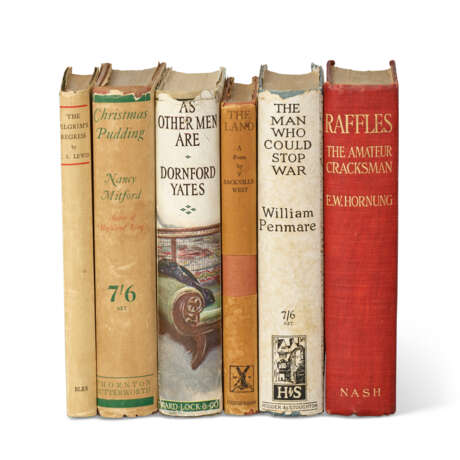ID 1028961
Lot 310 | British Literature: 6 works
Estimate value
£ 3 000 – 5 000
C. S. LEWIS (1898-1963). The Pilgrim’s Regress. London: Geoffrey Bless, 1943.
Presentation copy of the revised edition, inscribed by the author: ‘in memory of several pleasant and not unadventurous voyages’. Octavo. (Very light occasional marks, two marginal tears.) Original green cloth, spine with paper label printed in black and green, decorative map front endpapers (extremities lightly rubbed, front endpaper lightly spotted); original dust-jacket (backstrip sunned, head and foot lightly rubbed). Provenance: F. S. Goffin (authorial presentation inscription to half-title dated Oct. 1943).
MITFORD, Nancy (1904-1973). Christmas Pudding. London: Thornton Butterworth, 1932.
First edition of the author’s second novel in the rare dust-jacket. Octavo. Frontispiece and 11 illustrations by Mark Ogilvie-Grant. Original grey and red streaked cloth, spine and upper cover lettered in blue cursive (slightly cocked, spine ends just sunned); original dust-jacket (somewhat tanned and nicked, backstrip sunned, spine ends frayed, a few minor stains and small closed tears). Provenance: contemporary gift inscription (green ink to front pastedown, dated Xmas 1932).
YATES, Dornford (1885-1960). As Other Men Are. London: Ward, Lock & Co., Limited, 1925.
First edition. Octavo. (Some splitting to textblock, two minor marginal chips.) Original beige cloth spine and upper cover ruled and lettered in black, publisher’s device stamped in blind on lower cover (endpapers partially browned); original dust-jacket (somewhat chipped and creased, a few further closed tears, glue residue on verso).
SACKVILLE-WEST, Vita (1892-1962). The Land. London: William Heinemann Ltd., 1926.
First edition, presentation copy, of a book-length poem on the rural landscape. Octavo. Four pasted-in signed wood-cut illustrations by George Plank, leaves untrimmed (some leaves unopened). Original terracotta cloth, spine with white label titled in red (spine lightly sunned through excised piece in dust-jacket, endpapers partially browned); original printed dust-jacked designed by Plank (sunned, lightly nicked and stained, a few tiny closed tears, price exercised from the centre of backstrip). Provenance: Giselle Freund (authorial presentation inscription to front free endpaper, dated July 4. 1949) — contemporary annotation ascribing the wood-cuts to Plank (black ink, upper flap of dust-jacket) — William Heinemann Ltd (publisher’s label to rear free endpaper) — Sloane Bookshop (bookseller’s ticket to rear pastedown) — evidence of removed label to front free endpaper.
PENMARE, Williams (1893-1983). The Man Who Could Stop War. London: Hodder & Stoughton Limited, 1935.
First edition of a science fiction work about the thwarting of a Russian invasion. Octavo. 6 leaves of publisher’s ads at end (spotting to title and half-title, a few minor marks). Original blue cloth, spine lettered and with publisher’s device, upper cover titled and with author’s device, all stamped in black (extremities lightly rubbed, scattered white speckling, spine sunned); original dust-jacket priced at 7/6 (somewhat marked and dampstained, several small chips and closed tears). Provenance: The Book Room (stamp to front and rear free endpaper).
HORNUNG, E. W. (1866-1921). Raffles. The Amateur Cracksman. London: Evelyn Nash, 1906.
First edition of a short story collection featuring the famous gentleman thief. Octavo. 12 leaves of publisher’s ads at end (spotting). Original red cloth, spine and upper cover lettered in gilt (cocked, extremities faintly rubbed). Provenance: Henry Maitland Sperling and Mary Louise Sperling (bookplate) -- Graham Pollard (bookplate to front pastedown).
| Place of origin: | United Kingdom |
|---|
| Place of origin: | United Kingdom |
|---|
| Address of auction |
CHRISTIE'S 8 King Street, St. James's SW1Y 6QT London United Kingdom | ||||||||
|---|---|---|---|---|---|---|---|---|---|
| Preview |
| ||||||||
| Phone | +44 (0)20 7839 9060 | ||||||||
| Buyer Premium | see on Website | ||||||||
| Conditions of purchase | Conditions of purchase |









